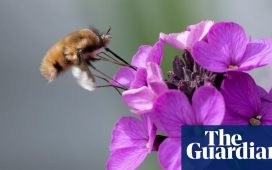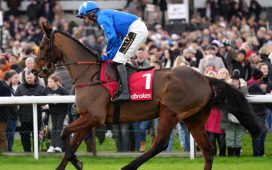A large herd of cattle has been let into an uncut field. Among the down-covered thistles and tall grasses, the cows, in bovine contentment, are spattering their dung freely. Just ahead of me, a cowpat lands on the ground with a celebratory slap. Nature’s nutrient-rich smoothie is packed with part-digested flower-stalks, seeds and grasses. Within minutes this glistening patty of insect fast food has become a complete miniature habitat.
Early arrivals include half a dozen greenbottles (Lucilia caesar), which have been biding their time nearby. They’re laying eggs within minutes but they scatter as a large noon fly lands. With its gold-leaf face mask, gloss-black body and orange delta wings, this Mesembrina meridiana is fly royalty.

Mesembrina meridiana is fly royalty.’ Photograph: Jeremy Dagley
However, it’s the tiny sepsid flies, cavorting crazily through the surrounding grass stems, like troupes of circus acrobats, that steal the show. Launching themselves into the cowpat arena, these shiny ant mimics scissor their iridescent wings in extravagant semaphore, refracting flashes of violet and ruby, before the males mount the females, circling away in a comical rodeo. Stock still, as if entranced by their craziness, minute lesser dung flies (Copromyza) patiently await mates.

This dipteran dung world is significant not only for its diversity but for its biomass. One average-sized cowpat may contain 1,000 insect larvae, and in a summer grazing season one cow’s dung could support a million flies. However, flies don’t have this nutritious world to themselves. I watch water scavenger beetles (Sphaeridium scarabaeoides) dropping out of the air, like armoured raindrops, into fresh cowpats. They make the first tunnels, helping dry and sculpt the dung. I uncover Colobopterus dung beetles working more fibrous patches, encumbered with fungivorous mites hitching a lift to join the food fest.

Aerated dung, baked in the sunshine, attracts a more cosmopolitan clientele. Grasshoppers and flesh flies sunbathe on the surface crust, crab spiders lurk in its crevices, while Myrmica ants nurse grubs in tunnelled interiors. Meanwhile, predatory rove beetles rove. Most eye-catching of these is Ontholestes murinus, its body hairs scattering ever-changing, distracting patterns of glittering bronze.
At a time when intensive cattle farming has become an environmental threat, the vital role of extensively grazed cows in supporting invertebrate (and insectivorous bird) biodiversity should be remembered. In this International Year of the Fly, it’s also something to celebrate.






